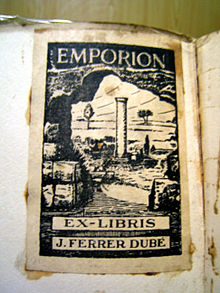Bookplate
Exlibris or ex libris (Latin phrase meaning, literally, "from among the books") is a brand of property that usually consists of a stamp (engraving), a label or a stamp that is usually placed on the back of the cover or cover of a book or on its first blank page (for example, on the title page), and that contains the name of the item's owner or owning library. The owner's name is usually preceded by the Latin expression ex libris (or also, frequently, ex bibliotheca or e-libris), although they can find variants (for example, "I am from..." or similar).
Features
In addition to the legend that accredits the book's belonging to a personal or institutional library, the exlibris generally also displays an image. The oldest examples use heraldic shields; images of allegorical or symbolic content also predominate (many times accompanied by some motto). The typology of images has been diversifying a lot: there are many, for example, those related to the profession, activity, trade or hobby of the owner of the book, there are also many of erotic content (which usually indicates that the copy belongs to a collection specialized in that theme), with a "macabre" (with skeletons or skulls alluding to the passage of time and death), monograms, etc. Motives related to the world of books and libraries are also frequent.
Techniques
Regarding the elaboration of bookplates, the techniques used have evolved and are very varied: before the invention of the printing press, bookplates consisted only of a handwritten annotation; Since the XV century, various engraving or stamping techniques have been used related to book arts (xylography, chalcography and others) and later also lithography, serigraphy, photoengraving and others). To these traditional procedures, design and computer printing or photographic reproduction were later added. Rubber or dry stamps are also used, which produce a stamping in relief.
A variant is known as superbooks, in which the written property mark and the image (usually heraldic) appear on the binding of the copy (embossed on the leather binding, embroidered on a cloth binding).
History
Amenhotep III (15th century BC)
A blue enameled terracotta plaque with hieroglyphic inscriptions, kept in the British Museum in London, which belonged to the Egyptian pharaoh Amenhotep III (15th century BC) and which would have been used, is usually cited as the first antecedent. as a property mark on the papyrus roll cases in his library.
King Fruela I of Asturias
As for Spain, the first known bookplate is that of King Fruela I (756-768), in the kingdom of Asturias.
Middle Ages
During the Middle Ages, there are examples of property marks in codices, which consisted of handwritten annotations.
Early Printing and Engraving
It is from the introduction of the printing press and the use of engraving techniques when we can already speak of ex libris in the modern sense of the term. As noted, they predominate in a first stage (from the XV century to the XVIII) those of heraldic type; From the 18th century allegories, symbols or emblems begin to prevail.
19th and 20th centuries: first collections and specialized publications and treatises
At the end of the 19th century and beginning of the 20th century, bookplates experienced a great flowering brought about by modernism. It is also at this turn of the century period, that of the rise of bibliophilia, when interest in this hobby (ex-librismo) grows, the first collectors appear, associations begin to emerge and congresses and competitions begin to be held. The first studies on the subject and the first specialized publications also appear at this stage. In Spain, the first treatise on exlibris was Doctor Thebussem (pseudonym of the scholar Mariano Pardo de Figueroa).
Collection of bookplates from the Royal Library
The Royal Library preserves an important and representative collection of exlibris. It is made up of three types of bookplates: those of the Royal Library; the personal ones, belonging to kings, queens or members of the Royal House, and the bookplates of bibliophiles, whose book collections were acquired or donated to the Royal Library.
Its database contributes to the study and dissemination of the library collections that are part of the Royal Library, since it identifies, describes and classifies the different marks of possession: the exlibris, super books and other personal marks.
The Count of Las Navas and his Printed Catalogue
The selection of the Royal Library has been developed from the historical and current bibliography on exlibris. The Count of Las Navas, in his Print Catalogue (1900), collected and reproduced some of the most common in the Royal Library. Matilde López Serrano, in Exlibris in the Palace Library (1947 and 1976), expanded this brief catalogue. Antonio Leandro Bouza, in his general treatise published in 1990, devoted special attention to the analysis and description of the bookplates belonging to monarchs and members of the Royal House. Heraldic superbooks have been added to this initial corpus, representative of the succession of reigns from Felipe II to Alfonso XIII.
Contenido relacionado
Serbian flag
John Locke
Boabdil



